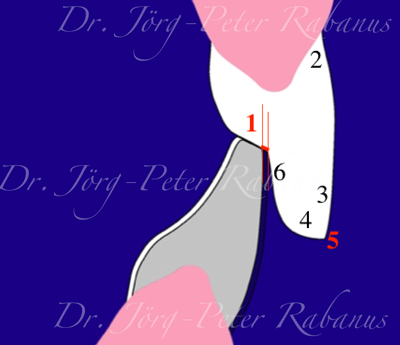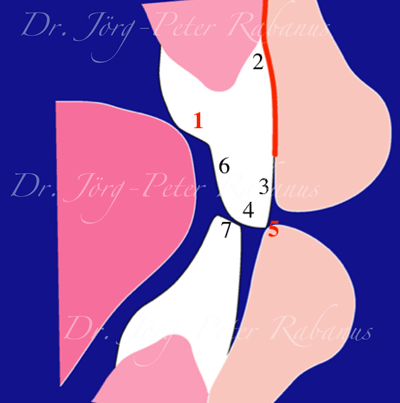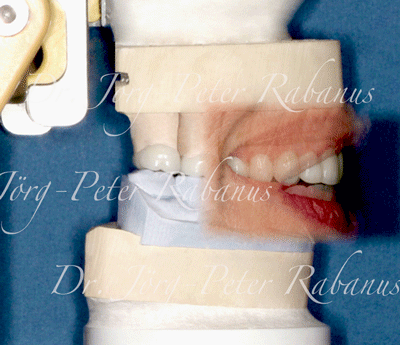A Smile Makeover Starts With The Positioning Of The Maxillary Central Incisor

Cosmetic dentistry and smile enhancement apply numerous technical and procedural principles. However, one paramount feature is the foundation of any smile design: the incisal edge position of the upper central incisor. (5)
Some cosmetic dentists refer to a "facially generated treatment planning." The goal is to determine and establish the best dental position for ideal facial aesthetics. The facial soft tissues, such as lips, chin, and muscular dynamics cannot be ignored. Once the optimum position of the incisal edge of the upper central incisors has been established, the dentist can proceed developing optimum gingival levels, vertical and horizontal positions of the remaining dentition, as well guidance paths.

The incisal edges of the upper central incisors relate to many different aspects of the oral cavity:
- The centric stops indicate the points of contacts between upper and lower teeth when the temporomandibular joints are in their "home" position (centric relation).
- The emergence profile of the gingival third of the upper anterior teeth provide lip support.
- The incisal third of the upper central incisors have to coincide with the natural lip closure path of the lower lip. This will ensure that the lower lip is neither strained nor trapped by the new tooth position. This area receives a lot of attention, because many intricate smile elements are established here. This includes incisal translucency, Halo effect, mammellons, and incisal notches. All of these attributes coincide with youthful teeth. Developmental dentin lobes are visible through the relatively transparent enamel of young teeth.
- The smile line is the curvature of the combined incisal edges of all upper anterior teeth, as they relate to the position and curvature of the upper lip.
- The incisal edge position is refined in relationship to the above described attributes as well as phonetic function.
Once the ideal position of the upper central incisors has been determined, the remaining teeth can be designed, if necessary, to establish appropriate vertical and horizontal tooth positions and a design of their contact surfaces that will assure harmonic guidance pathways that do not interfere with the natural envelope of function of the individual masticatory system.

No expertise in technical procedures can replace the need of a thorough evaluation of oral function. The collection of all necessary information and its transfer to the models at the dental laboratory require a sound understanding of the natural physiology of a human mouth, the mechanics of the temporomandibular joints, and the relationship and function of upper and lower teeth together.
Any treatment plan of comprehensive cosmetic dentistry needs to visualize the ideal end result. The sequence and timing of the individual treatment steps are determined by the desired treatment outcome. Even the amount of tooth reduction is determined by the desired final position and outline of the new porcelain veneers or other dental restorations. Cosmetic dentists have to determine where the optimum maxillary tooth position and the gingival levels are relative to the patient's face. This will determine the principal route of treatment, such as orthodontics and/or smile design with porcelain restorations. In some cases, it can be predetermined that much more comprehensive treatment modalities, such as maxillofacial surgery, may be necessary to obtain the optimum result. It is important that the patient understands his or her individual dental condition and what options are available to obtain a healthy and beautiful new smile.
The mandibular teeth have to be evaluated to determine whether they accommodate the proposed new tooth positions of the upper dental arch. It goes without saying that none of this would make sense without assurance that the mandibular joint is healthy and functions flawlessly in the temporal fossa. Only from this articular "home" position, we can analyze how teeth should relate to each other to accommodate for proper masticatory function. These issues are discussed on our page about smile makeovers in comprehensive cosmetic dentistry.
References:
- Sarver DM, et al. Dynamic smile visualization and quantification: part 1. Evolution of the concept and dynamic records for smile capture. Am J Orthod Dentofacial Orthop 2003,124: 4-12.
- Sarver DM, et al. Dynamic smile visualization and quantification: Part 2. Smile analysis and treatment strategies. Am J Orthod Dentofacial Orthop 2003, 124: 116-127.
- Vig RG, et el. The kinetics of anterior tooth display. J Prosthetic Dentistry 1978, 39: 502-504.
- Kokich VG, et al. Esthetics and vertical tooth position: orthodontic possibilities. Compend Contin Educ Dent 1997, 18: 1225-1231.
- Sarver DM, et al. The importance of incisor positioning in the esthetic smile: the smile arc. Am J Orthod Dentofacial Orthop 2001, 120: 98-111.
- Kokich VG. Esthetics and anterior tooth position: an orthodontic perspective. Part II: vertical position. J Esthetic Dentistry 1993: 5: 174-178.
- Kokich VG, Spear FM. Guidelines for managing the orthodontic-restorative patient. Semin Orthod 1997; 3: 3-20.


